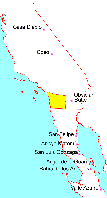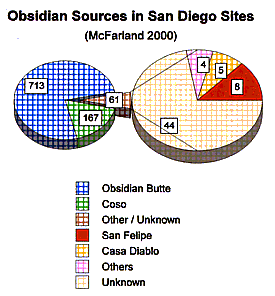Baja California Obsidian
Two main source areas supplied most of the obsidian that was used prehistorically in San Diego: Coso Volcanic Field, the primary source during the Archaic period, and Obsidian Butte, the primary Late Prehistoric source (cf. Hughes and True 1985:332). Other source areas east of the Sierra Nevada, such as Casa Diablo and Truman/Queen, are only very rarely represented in San Diego assemblages. In addition, a number of specimens have been tagged as coming from “unknown sources.” Pinning down the unknown sources of obsidian in San Diego sites should help clarify the extent of the exchange networks into which local groups were linked and the changes that those networks underwent through time.
 Several investigators have addressed potential sources of obsidian in northeastern Baja California:
Several investigators have addressed potential sources of obsidian in northeastern Baja California:
- Tom Banks (1971) noted the presence of obsidian near San Felipe, on the Gulf of California coast.
- Ron Douglas (1981) reported obsidian at Arroyo Matomí, about 60 kilometers south of San Felipe.
- Paul Bouey (1984) published some x-ray fluorescence characterization data on San Felipe obsidian.
- Richard Hughes (1986) included fragmentary data on Arroyo Matomí obsidian in an article on Obsidian Butte.
- Jonathon Ericson reported using as standards of comparison obsidian samples from “Matamo” [cf. Arroyo Matomí?], Mexicali, and “Isla Encontada” [cf. Isla Encantada, north of Bahía San Luis Gonzaga] (Townsend 1986). Ericson also listed some characterization data on samples from Baja California archaeological sites SDM-LC-73, SDM-LC-74, and SDM-LC-75, assigned to the “Matamo” source. Ericson’s rubidium, strontium, and zirconium values for these specimens seem to agree fairly well with Bouey’s values for the San Felipe source.
- Recently, several investigators have chemically identified an assortment of obsidian sources in northeastern Baja California (Panich, Michelini, Bendímez, and Shackley 2013; Panich, Michelini, and Shackley 2012, 2013; Téllez et al. 2013). Some of the sources are known on the ground at quarry sites, while the exact locations of others, including the San Felipe source, have not yet been identified. The additional sources have not yet been reported for sites in San Diego County.
- Other source areas farther south along Baja California’s eastern coast have also been identified, although it may be unlikely that their products reached areas north of the border. These sources include Bahía San Luis Gonzaga, Isla Angel de la Guarda, another source probably close to Bahía de los Angeles, and Punta Mangles north of Loreto (Bouey 1984; Shackley 1994, 1995, 1997).
Possible specimens of Baja California obsidian have been reported from several San Diego archaeological sites:
- Paul Bouey performed x-ray fluorescence analysis on a piece of obsidian from the Late Prehistoric village site of Rinconada de Jamo (SDI-5017) in Pacific Beach and assigned it to the San Felipe source (Winterrowd and Cardenas 1987).

- Based on x-ray fluorescence data on obsidian from unknown sources in other San Diego County sites, Don Laylander (1989a) identified an additional nine specimens that appeared to be assignable to the same source as the Rinconada de Jamo specimen (Corum 1986; Corum and White 1986; Dominici 1984, 1985; Laylander 1986, 1989b; Laylander and Christenson 1988a). Three other chemically similar specimens were reported by Andrew Pigniolo and Dennis Gallegos (1990). The chemical characteristics of these 13 specimens included relatively high proportions of strontium and relatively low proportions of thorium, yttrium, zirconium, and niobium. If the specimens came from a single source, that source was the third most abundantly represented one in San Diego sites, after Obsidian Butte and Coso. The specimens were found in contexts that seem to belong both to the Late Prehistoric period and to earlier periods.
- Meg McDonald (1992) reported 18 out of a sample of 239 chemically sourced obsidian specimens (7.5%) at Indian Hill Rockshelter (SDI-2537) in extreme southeastern San Diego County as probably being attributable to the San Felipe source. She also assigned to that source one item in a sample of 26 specimens from the McGowan Site (SDI-12,809) in the Otay area (McDonald et al. 1993).
Sharon McFarland (2000) collected data on 491 chemically sourced obsidian specimens from San Diego sites, including eight specimens that were at least tentatively assigned to the San Felipe source. According to this data set, San Felipe was the region’s third most common obsidian source, although it trailed far behind Obsidian Butte and Coso. Some additional data are also included in the table below.
| Site SDI- | Sourced Obsidian Specimens |
Specimens Tentatively Assigned to San Felipe Source |
Hydration Readings on Possible San Felipe Specimens |
References |
| 2537 | 239 | 18 | 1.0, 1.1, 1.6 | Bouey and Onken 1986; McDonald 1992 |
| 4615 | 1 | 4.5 | Laylander 1986a | |
| 5017 | 10 | 1 | 5.5 | Winterrowd and Cardenas 1987 |
| 5383 | 8 | 1 | 4.9 | Laylander 1989a |
| 5680 | 66 | 1 | 4.3 | Dominici 1984, 1985 |
| 7197 | 3 | — | Pigniolo and Gallegos 1990a | |
| 8556 | 2 | 1 | 3.2 | McFarland 2000 |
| 9242 | 4 | 1 | — | Corum 1986 |
| 9243 | 48 | 2 | 1.0, 5.5 | Carrico et al. 1994; Corum and White 1986; McDonald et al. 1994 |
| 9448 | 3 | 1 | — | Laylander and Christenson 1988a |
| 9750 | 4 | 1 | 3.1 | Laylander and Christenson 1988a |
| 11,952 | 2 | 2 | 4.7, 10.5 | McFarland 2000 |
| 12,809 | 26 | 1 | — | McDonald et al. 1993 |
| 12,947 | 11 | 3 | 1.9, 3.5, 4.4 | McFarland 2000 |
PROSPECTS
Future investigations may be able to confirm the identification of obsidian specimens in San Diego archaeological sites as having been made from material coming from one or more geological source areas in northern Baja California. Studies may shed light on the relative frequency of San Felipe obsidian in these sites as compared with material from Obsidian Butte and Coso Volcanic Field, as well as changes in its relative frequency through time and in different portions of the San Diego region.